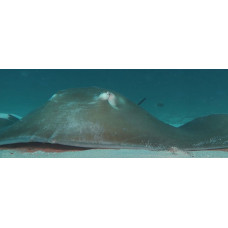Latin name
Pateobatis fai
Other names
Pateobatis fai
Identification
Pectoral fin disk, thickened in the middle, about 1.1-1.2 times as wide as long. The outer corners of the disc are angular. The snout forms a very blunt angle with a barely protruding tip. Small, widely spaced eyes are followed by larger spiracles. Between the long, narrow nostrils is a short, broad skin band with a thin fringe at the back. The mouth is rather small and surrounded by prominent furrows; the lower jaw has a slight indentation in the center. The floor of the mouth has two large central papillae and two small lateral papillae. The teeth are small and arranged in a paving pattern. Five pairs of gill slits are located below the disc.
The tail is extremely long and thin, at least twice the length of the disc when intact. It lacks fin folds and usually has a single serrated barb. Adults have small rounded dermal spines that cover the central dorsal surface of the disc, beginning in front of the eyes and extending across the tail; there are also small sharp spines on the midline, most densely at the base of the tail. Young individuals have either smooth skin or a sparser layer of flat, heart-shaped denticles.
Features of fish fins
The pectoral fin disk is diamond-shaped. The pelvic fins are small and narrow.
Fish colouring
This species has a uniform coloration of grayish to brownish pink on top, dark gray to black on the tail behind the sting, and uniformly pale underneath.
Distribution
The exact range is unclear due to confusion with H. jenkinsii. It is thought to be distributed in the tropical waters of the Indo-Pacific, probably occurs throughout the Indian Ocean periphery from South Africa to northern Australia, appears in the Red Sea. Its range extends into the Pacific Ocean, north to the Philippines, Ryukyu and Iriomote Islands, and east to various islands including Micronesia, the Marquesas Islands and Samoa.
Habitat
A marine tropical species. Has been seen at depths of 200 m (660 ft), but is usually found in the intertidal zone at depths of 70 m (230 ft). This bottom-dwelling species prefers sandbars, lagoons, and other soft-bottom habitats, often near bays and atolls in coral reefs. It tends to be found closer to shore during the warm season.
Size
Reaches at least 1.8 m (5.9 ft) in diameter and over 5 m (16 ft) in length. Its maximum record weight is 19 kg (42 lb).
Behavior
Studies on Polynesian islands have shown that individuals tend to stay within a single localized area, with very little movement between islands.
Small and large aggregations of stingrays have been observed over sandbars and coral reefs in Shark Bay, the Great Barrier Reef and the Caroline Islands. Up to ten individuals may sit on top of each other while resting, sometimes mixing with other species. At Ningaloo Reef it has been observed "riding" larger species of stingrays.
Food and feeding habits
They feed mainly on ten-legged crustaceans, but also on cephalopods and bony fish. In Shark Bay, Penaeidae are by far the primary prey of stingrays of all sizes. At Rangiroa Atoll in French Polynesia, large feeding aggregations are known to form in shallow waters at night.
Reproduction
Like other stingrays, they are placental, and the mother supplies her developing embryos with nutrient-rich histotrope ("uterine milk") through specialized uterine structures. Newborns reach 55-60 centimeters (22-24 inches) in diameter. Shark Bay may be a breeding area for this species. Males reach sexual maturity at 1.1-1.2 m (3.6-3.9 ft) in diameter, while the size of females is unknown.
Fishing
This species is a common incidental target of coastal fisheries using entangling nets, bottom trawls, gillnets, and seines.
Relationship with a person
Not very dangerous to humans. Its meat, skin and cartilage are used. Valuable for ecotourism in the Maldives, French Polynesia and elsewhere.
| Classification | |
| Phylum | Chordata |
| Class | Chondrichthyes |
| Squad | Myliobatiformes |
| Family | Dasyatidae |
| Genus | Pateobatis |
| Species | P. fai |
| Features | |
| Conservation status | Vulnerable |
| Habitat | Bottom |
| Life span, years | No information |
| Maximum body weight, kg | 19 |
| Maximum length, cm | 500 |
| Sailing speed, m/s | No information |
| Threat to people | Edible |
| Way of eating | Predator |
Pink whipray
Tags: pink whipray



